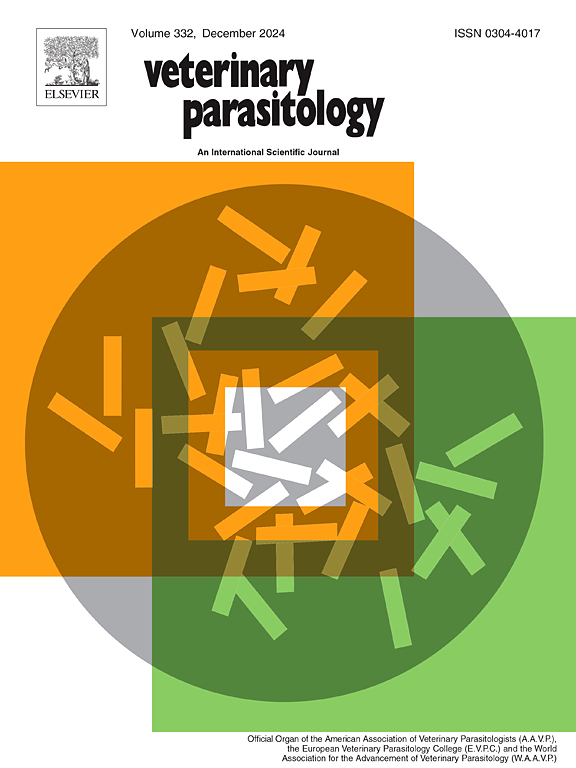基于酶联免疫吸附试验的重组副猪隐孢子虫 GP15 检测牛群中隐孢子虫暴露情况
IF 2
2区 农林科学
Q2 PARASITOLOGY
引用次数: 0
摘要
采用酶联免疫吸附试验(ELISA)评价了重组小隐孢子虫糖蛋白15 (rCpGP15)在印度北部喜马偕尔邦和北阿坎德邦牛隐孢子虫暴露中的血清诊断潜力。11.13 kDa rCpGP15在pET-32a(+)转化的大肠杆菌BL21细胞中表达,并通过Ni-NTA亲和层析纯化为多组氨酸标记的~ 32 kDa融合蛋白。用重组抗原培养的兔抗血清和自然感染隐孢子虫的牛血清western blot检测其免疫原性。采用改良的ziehl - Neelson技术对246头牛粪便中隐孢子虫卵囊进行筛选,并将其血清用于ELISA标准化。基于rCpGP15的间接IgG-ELISA标准化,灵敏度为83% %,特异性为78.3% %,通过ROC曲线分析确定ELISA的截止点和准确性。准确度为79.19 %,受试者工作特征(ROC)曲线下面积为0.827,准确度中等。此外,血清从艾美球虫属(n = 3),圆形线虫(n = 3),巴贝西虫(n = 2)焦(n = 5),锥虫属(n = 2)和红孢子虫属(n = 5)没有seroreactivity积极的动物。通过计算机B细胞表位预测、同源性建模和结构比较,预测了rCpGP15蛋白对细小隐孢子虫、人源隐孢子虫、牛隐孢子虫和瑞安隐孢子虫的鉴别诊断作用。利用SVMTrip预测CpGP15蛋白序列的4个线性抗原表位。CpGP15与人猿C.、牛C.和部分ryanae C. GP15同源性建模和结构比较的总体均方根偏差(RMSD)分别为2.093 Å、3.759 Å和1.152 Å。在本研究中开发的血清诊断分析具有中等的准确性,可以应用于大规模牛群体的血清监测。该方法能够检测出隐孢子虫间歇性卵囊脱落的无症状动物,这将有助于更好地了解隐孢子虫病的发病动态和及时控制隐孢子虫病。本文章由计算机程序翻译,如有差异,请以英文原文为准。
Recombinant Cryptosporidium parvum GP15 based enzyme linked immunosorbent assay for detection of exposure of bovine populations to Cryptosporidium
The serodiagnostic potential of recombinant Cryptosporidium parvum glycoprotein 15 (rCpGP15) was evaluated in Enzyme Linked Immunosorbent Assay (ELISA) in the detection of exposure of bovines to Cryptosporidium species in Himachal Pradesh and Uttarakhand states of North India. The 11.13 kDa rCpGP15 was expressed in pET-32a (+) transformed E. coli BL21 cells and was purified by Ni-NTA affinity chromatography as polyhistidine tagged fusion protein of ∼ 32 kDa. Its immunogenicity was checked in western blot using rabbit antisera raised to the recombinant antigen and bovine sera naturally infected with Cryptosporidium. Two hundred and forty-six bovines were screened for Cryptosporidium spp. oocysts in faecal samples by modified-Ziehl Neelson technique and their sera were used for ELISA standardization. The rCpGP15 based indirect IgG-ELISA was standardized with 83 % sensitivity, 78.3 % specificity where ELISA cut-off and accuracy were decided using ROC curve analysis. The percent accuracy was 79.19 %, with area under the Receiver Operating Characteristic (ROC) curve value 0.827 depicting the moderate accuracy of the assay. Additionally, sera from Eimeria (n = 3), strongyles (n = 3), Babesia (n = 2), Theileria (n = 5), Trypanosoma (n = 2) and Anaplasma (n = 5) positive animals showed no seroreactivity. The diagnostic performance of rCpGP15 protein in differentiating Cryptosporidium species was predicted through in-silico B cell epitope prediction, homology modelling and structural comparison of GP15 protein from C. parvum, C. hominis, C. bovis and C. ryanae. Four linear antigenic epitopes were predicted in CpGP15 protein sequence by SVMTrip. The overall root mean square deviation (RMSD) values during homology modelling and structural comparison of CpGP15 and C. hominis, C. bovis and partial C. ryanae GP15 were 2.093 Å, 3.759 Å and 1.152 Å, respectively. The serodiagnostic assay developed in the present study has moderate accuracy and can be applied in serosurveillance of large bovine populations. It is capable of detecting asymptomatic animals with intermittent oocyst shedding which will further be helpful for better understanding the disease dynamics and for the timely control of cryptosporidiosis.
求助全文
通过发布文献求助,成功后即可免费获取论文全文。
去求助
来源期刊

Veterinary parasitology
农林科学-寄生虫学
CiteScore
5.30
自引率
7.70%
发文量
126
审稿时长
36 days
期刊介绍:
The journal Veterinary Parasitology has an open access mirror journal,Veterinary Parasitology: X, sharing the same aims and scope, editorial team, submission system and rigorous peer review.
This journal is concerned with those aspects of helminthology, protozoology and entomology which are of interest to animal health investigators, veterinary practitioners and others with a special interest in parasitology. Papers of the highest quality dealing with all aspects of disease prevention, pathology, treatment, epidemiology, and control of parasites in all domesticated animals, fall within the scope of the journal. Papers of geographically limited (local) interest which are not of interest to an international audience will not be accepted. Authors who submit papers based on local data will need to indicate why their paper is relevant to a broader readership.
Parasitological studies on laboratory animals fall within the scope of the journal only if they provide a reasonably close model of a disease of domestic animals. Additionally the journal will consider papers relating to wildlife species where they may act as disease reservoirs to domestic animals, or as a zoonotic reservoir. Case studies considered to be unique or of specific interest to the journal, will also be considered on occasions at the Editors'' discretion. Papers dealing exclusively with the taxonomy of parasites do not fall within the scope of the journal.
 求助内容:
求助内容: 应助结果提醒方式:
应助结果提醒方式:


